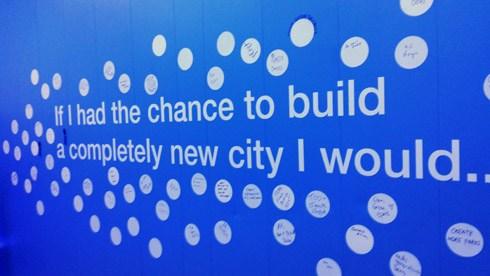
Editor's Note: This post is part of TriplePundit's coverage of BASF Creator Space: New York, held May 26 through May 31 in NYC. Check back for more coverage here on 3p.
Chemical giant BASF has been a supplier to the construction industry for most of its 150-year history. That’s a multi-stakeholder business if there ever was one. It’s a great place to learn about engagement, which might just be the key to the company’s success.
So, its Creator Space Summits, which will take place in New York City, Mumbai, Shanghai, Sao Paolo, Barcelona and Ludwigshaven, are a natural way for them to commemorate their sesquicentennial, by inviting an array of co-creators to wrestle with challenging problems of our time.
The NYC event is grappling with the question of the future of Red Hook, a vibrant, ethnically and economically diverse neighborhood at the southern tip of Brooklyn, which lies almost entirely inside the flood zone designated by FEMA in the aftermath of Sandy, the hurricane that devastated the area. Gathered in a spirit of collaboration were dozens of architects, engineers, designers, artists and Red Hook residents. The conveners raised difficult questions. Can the people and property of Red Hook be protected from future storms? Should people even be living there as the oceans rise? Can protection be provided without turning the place into a soulless fortress?
Yes, we put a man on the moon, but what was the quality of life aboard an Apollo spaceship? BASF CEO Wayne T. Smith welcomed the group with this message. "At BASF, we believe that chemistry is a fundamental enabler to many of the potential solutions of many of these problems. As we celebrate this milestone, we are connecting people with ideas to make meaningful contributions to society in accordance with our corporate purpose: 'We create chemistry for a sustainable future.’” Alex Washburn, founding director of the Center for Coastal Resilience and Urban Xcellence at Stevens Institute of Technology, added in the opening roundtable, “We need to start thinking like Renaissance men.”
The group broke up into three subject areas: citizenship, habitat and resilience, and workshopped problem statements and solutions.
Providing inspiration to the teams was a viewing of the film "Urbanized," introduced by the director Gary Hustwit, and a talk by futurist Alex Steffen, author of "Worldchanging" and "Carbon Zero."
Among the solutions developed by the teams were:
- A hybrid storm protection system that would include permanent barriers surrounding the oceanfront -- creating a shallow embayment, topped with a bike path, supplemented with deployable flood barriers in the most vulnerable parts of the neighborhood. (Resilience)
- A Red Hook Resiliency Toolkit, developed for and by building owners and residents in the community with input from various experts. (Resilience)
- A Utopia Task Force described numerous ways to improve the lives and increase inclusion of the substantial population living in public housing. Goals are to increase homeownership, build community and improve economic conditions through an incubator. (Citizenship)
- I Am Many aims to provide a bridge between the diverse inhabitants of Red Hook, level the influence playing field and encourage local entrepreneurs. (Citizenship)
- A green corridor to provide cohesion and connectedness in the community with a green corridor including green space, pedestrian and bike paths, clean energy, and drainage features (Habitat)
- Red Hook Rebirth: a replicable site-plan template for a single city block featuring low-rise multi-use buildings. The plan includes the elements of architecture, public green space, social programs and energy. A key success element of this plan is resource sharing at the block level as a social unit. (Habitat)
Throughout the event was an optimism that seemed to say, “We can figure this out.” It was clearly about moving forward, not backward, whether it was Wayne T. Smith talking about chemistry’s contribution or Alex Steffen talking about building our way out of this mess.
Even though these same factors -- building, chemistry and growth -- are often placed at the heart of our ecological crisis, there was a sense permeating the room here, insistent as a drumbeat, that it is far more a matter of doing these things correctly, than it is about doing less of them or not doing them at all.
Image credits: RP Siegel

RP Siegel (1952-2021), was an author and inventor who shined a powerful light on numerous environmental and technological topics. His work appeared in TriplePundit, GreenBiz, Justmeans, CSRWire, Sustainable Brands, Grist, Strategy+Business, Mechanical Engineering, Design News, PolicyInnovations, Social Earth, Environmental Science, 3BL Media, ThomasNet, Huffington Post, Eniday, and engineering.com among others . He was the co-author, with Roger Saillant, of Vapor Trails, an adventure novel that shows climate change from a human perspective. RP was a professional engineer - a prolific inventor with 53 patents and President of Rain Mountain LLC a an independent product development group. RP was the winner of the 2015 Abu Dhabi Sustainability Week blogging competition. RP passed away on September 30, 2021. We here at TriplePundit will always be grateful for his insight, wit and hard work.














